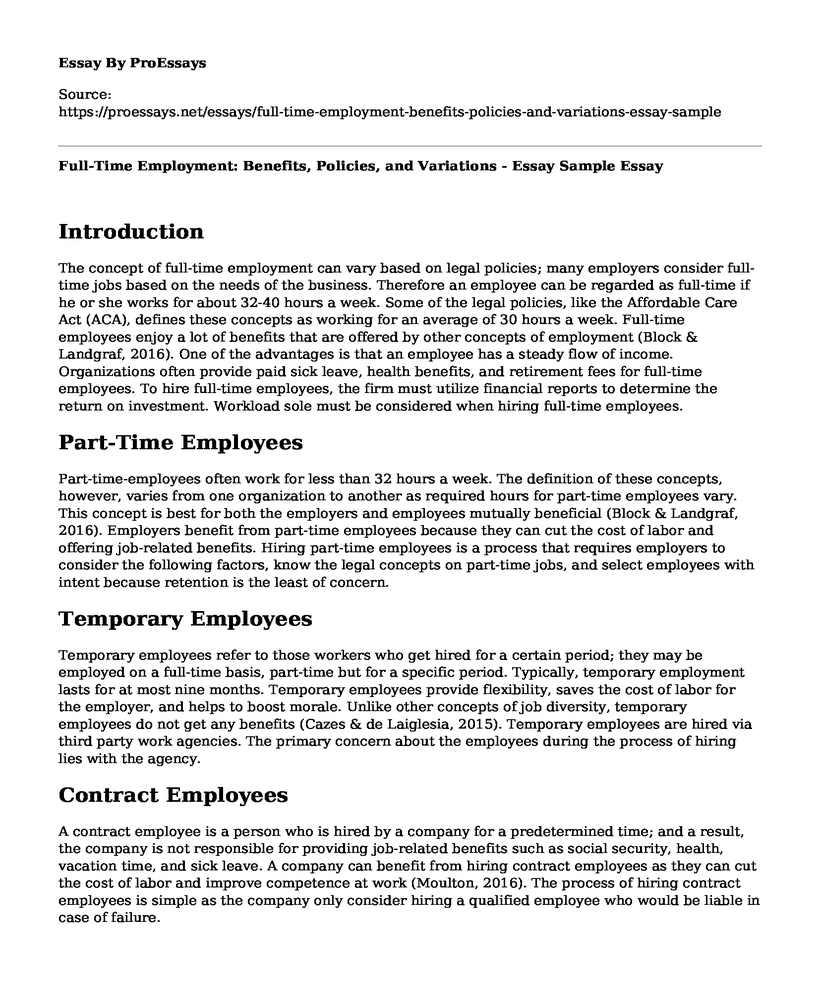Introduction
The concept of full-time employment can vary based on legal policies; many employers consider full-time jobs based on the needs of the business. Therefore an employee can be regarded as full-time if he or she works for about 32-40 hours a week. Some of the legal policies, like the Affordable Care Act (ACA), defines these concepts as working for an average of 30 hours a week. Full-time employees enjoy a lot of benefits that are offered by other concepts of employment (Block & Landgraf, 2016). One of the advantages is that an employee has a steady flow of income. Organizations often provide paid sick leave, health benefits, and retirement fees for full-time employees. To hire full-time employees, the firm must utilize financial reports to determine the return on investment. Workload sole must be considered when hiring full-time employees.
Part-Time Employees
Part-time-employees often work for less than 32 hours a week. The definition of these concepts, however, varies from one organization to another as required hours for part-time employees vary. This concept is best for both the employers and employees mutually beneficial (Block & Landgraf, 2016). Employers benefit from part-time employees because they can cut the cost of labor and offering job-related benefits. Hiring part-time employees is a process that requires employers to consider the following factors, know the legal concepts on part-time jobs, and select employees with intent because retention is the least of concern.
Temporary Employees
Temporary employees refer to those workers who get hired for a certain period; they may be employed on a full-time basis, part-time but for a specific period. Typically, temporary employment lasts for at most nine months. Temporary employees provide flexibility, saves the cost of labor for the employer, and helps to boost morale. Unlike other concepts of job diversity, temporary employees do not get any benefits (Cazes & de Laiglesia, 2015). Temporary employees are hired via third party work agencies. The primary concern about the employees during the process of hiring lies with the agency.
Contract Employees
A contract employee is a person who is hired by a company for a predetermined time; and a result, the company is not responsible for providing job-related benefits such as social security, health, vacation time, and sick leave. A company can benefit from hiring contract employees as they can cut the cost of labor and improve competence at work (Moulton, 2016). The process of hiring contract employees is simple as the company only consider hiring a qualified employee who would be liable in case of failure.
Independent Contractor
An Independent contractor is the concept of employment in which an individual or contract entity is assigned to carry out a particular job. In many cases, an independent contractor involves a corporation or an organization that provides goods or services to individuals or companies under a verbal or written agreement. Unlike other concepts, independent contractors do operate regularly for a specific employer (Moulton, 2016). The process of hiring an independent contractor involves legal contracts on terms and conditions.
Exempt Employee
Except employee is job concept that refers to the category of employees identifies in the Fair Labor Standard Act acts as an employee who earns a substantial income and whose duties do not make them qualified for minimum wage requirements and overtime pay. Usually, exempt employees are hired as salaried workers from executive roles (Nadel, Pritchard & Schmidt, 2019). They are paid for the number of hours they work and not for the job they perform. The process of hiring exempt employees involves the considerations of the number of hours worked and the position they occupy for the given opportunity. Laws and regulations are required in determining terms and conditions during the hiring process.
Non-Exempt Employees
None-exempt employees refer to employees who are not exempted from FLSA requirements; workers who fall in this category are eligible for federal minimum wage and overtime pay as well. Their rights and job guidelines are outlined in the FLSA (Nadel, Pritchard & Schmidt, 2019). Furthermore, this category of employees is expected to responsibly carry out their duties without applying their own managerial decisions. The hiring process of non-except employees is determined by the legal guidelines to provide in FLSA. The company must consider eligible befits and the cost of labor when hiring non-except employees.
References
Block, J. H., & Landgraf, A. (2016). The transition from part-time entrepreneurship to full-time entrepreneurship: the role of financial and non-financial motives. International entrepreneurship and management journal, 12(1), 259-282.
Cazes, S., & de Laiglesia, J. R. (2015). Temporary contracts and wage inequality. In Labour markets, institutions, and inequality. Edward Elgar Publishing.
Moulton, D. W. (2016). The Unexpected Consequences of Classifying Exotic Dancers as Employees or Independent Contractors under the FLSA. NCL Rev. Addendum, 95, 83.
Nadel, S. A., Pritchard, A., & Schmidt, A. (2019). The Impact of the FLSA Overtime Rule on Higher Education. College and University Professional Association for Human Resources.
Cite this page
Full-Time Employment: Benefits, Policies, and Variations - Essay Sample. (2023, Aug 09). Retrieved from https://proessays.net/essays/full-time-employment-benefits-policies-and-variations-essay-sample
If you are the original author of this essay and no longer wish to have it published on the ProEssays website, please click below to request its removal:
- Geographical Expansion of Business Essay
- Essay Sample on Social Impact of Business
- Essay on AACN Research Results: Diabetes and Cancer Rate Increase With Globalization
- Paper Example on Global Trade: China's Dominance in 21st Century Economy
- Essay Example on Performance-Based Pay: Merit, Recognition, Incentives & Earnings
- Employees: Essential for Gaining Strategic Advantage in Competitive World - Essay Sample
- Essay Example on Cultural Individualism in the USA and Kenya: A Comparison







